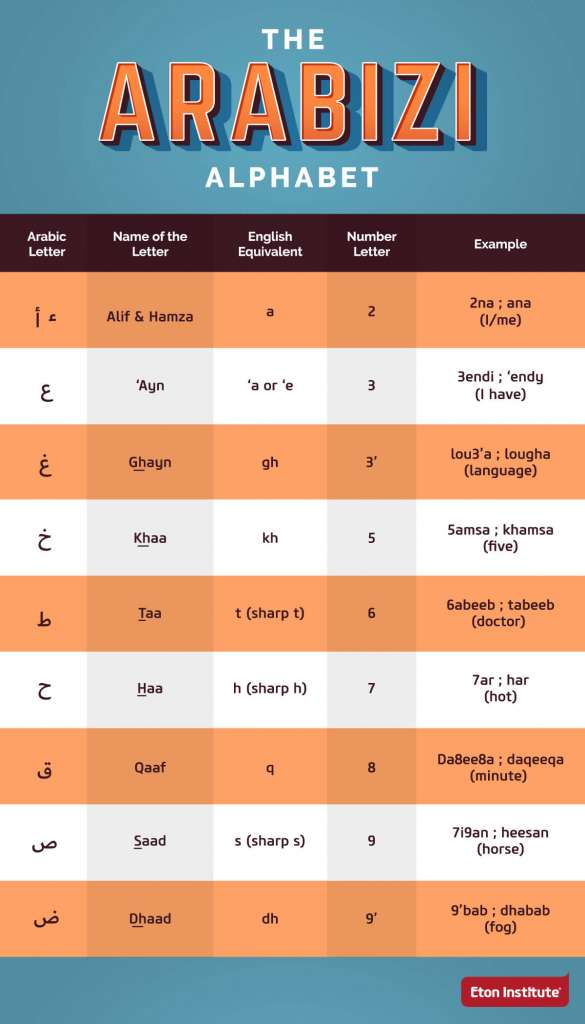2020 has been a year marked by conversations about racism and colonialism taking their rightful place in the mainstream. So the convergence of conversations about racism in society and racism in technology is of no surprise. And Eurocentrism of digital media. People have compared facebook’s global expansion to colonialism, noting the similarities in savior narratives, references to themes of equality, democracy, basic rights, partnership with local elites and accusations of ingratitude in responce to criticism. There is talk of digital colonialism, refering to control of data and computational powers, racism in facial recognition technology and bias in HR pre-selection algorithms. But upon a closer look one might find that inequality is built-in in this structure on a very basic, hidden level. And still it can affect the real world in unexpected and profound ways.
Franco-Arabic, also known as Arabizi or the Arabic Chat Alphabet is one example of such impact. Writing systems other than latin script were not considered when designing communication technology, and this is an issue to this day, with one example being Adobe software not supporting Arabic text. Franco-Arabic is a way of writing Arabic with latin alphabet, using numbers for sounds that cannot be represented. Franco-Arabic appeared and rose in popularity as a texting language for a rather simple, crude, but probably surprising for speakers of latin script-based languages reason – cost and space. Texts were more expensive because a single character of a non-latin alphabet was considered to weigh more and therefore cost more. The character limit was considerably higher if you typed in English. Popular chatting programs, such as MSN didn’t support the Arabic language. I only caught a very brief period of the presence of this unfortunate feature when I first started texting in Russian. We used latin script and abbreviations, but it did not stick. Unlike the latinised Russian varieties, The Arabic Chat Alphabet is commonly used in written digital communication to this day across Arabic speaking countries and diaspora.
The Russian alphabet has 32 letters and the writing is quite similar to European languages. In the case of Arabic, the total number of glyphs in traditional printing is over four hundred in some typefaces. If other languages that use Arabic letters such as Farsi and Urdu are included, then the total number of glyphs at the most basic level would exceed three hundred. Many people who use this way of spelling, or as some would claim a language of its own, attribute it to speed and convenience in comparison to typing in Arabic.

In is article on Franco-Arabic Yaghan claims there the rise and popularity is due to the advancement of the Internet and English as the language of global communication without any imperialist implications. How can this be possible? How can the advancement of a technology originating from specific political conditions of Cold War USA, simply not designed for most non-European peoples, be without imperialist implications? Did the decades and in some cases centuries of imperial rule and their impact magically dissolve after colonialism’s formal end? If you’re building a world brain, shouldn’t it speak the languages of the world?
During my time at the American University in Cairo two years ago, I met many people who use Franco-Arabic. Some of them were Egyptians, who grew up both abroad and in Egypt, who did not have sufficient command of the arabic alphabet and language to read and write in it. It didn’t present a problem. All the courses were taught in English as the de-facto default language of the education sphere in Egypt and many other countries formerly colonised by Great Britain. One can easily speak to their family and friends and people around in Egyptian Arabic, watch movies and listen to music in it, read enough for daily life but not enough for books and articles, and write In Franco-Arabic. I could clearly see the role of institutions and processes originating in colonial rule such as European-curriculum and language school education in Egypt playing a large part in this reliance of Franco-Arabic in lieu of the Arabic alphabet as a necessity rather than a choice.
Many don’t see it as a threat to their linguistic or other identity. Ironically, today this creation of the digital media poses a problem in itself to outsiders – when searching for academic articles about Arabizi, most that I saw were are about its detection and translation, which proves to be rather complicated. It also offers some extra details to communication that writing in Arabic doesn’t, such as upper- and lowercase letters to express calmness or shouting, or, as it is phonetic, it can reveal someone’s native dialect very precisely, depending on the social status of the speaker and on the group, sex, and origin.
Today there is little practical need for the use of Franco-Arabic, yet it is still very popular amongst the youth. Even handy tools have been created to translate this writing system into Arabic proper.
In this case the Eurocentrism of digital media on a quite basic level had a long-lasting effect on the way people communicate with each other, even if it is mostly limited to chatting and writing online.
Yaghan, Mohammad Ali. ““Arabizi”: A contemporary style of Arabic Slang.” Design issues 24, no. 2 (2008): 39-52.


Recent Comments